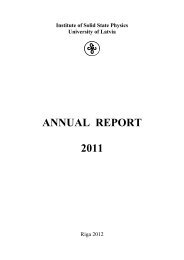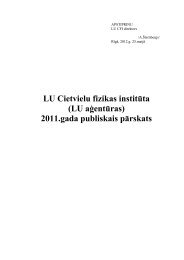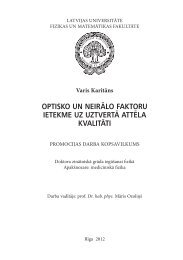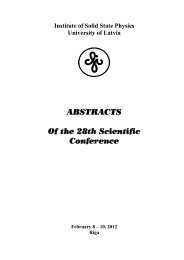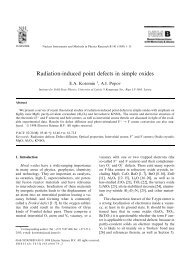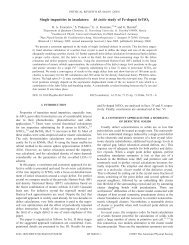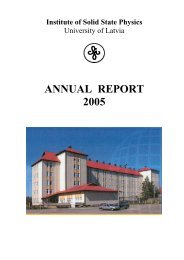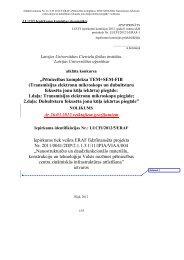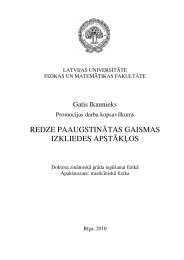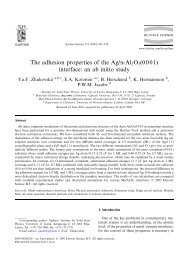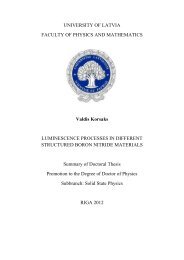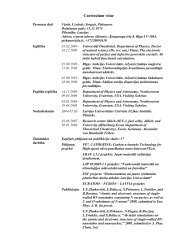Annual Report 2012 - Latvijas Universitātes Cietvielu fizikas institūts
Annual Report 2012 - Latvijas Universitātes Cietvielu fizikas institūts
Annual Report 2012 - Latvijas Universitātes Cietvielu fizikas institūts
Create successful ePaper yourself
Turn your PDF publications into a flip-book with our unique Google optimized e-Paper software.
Titania with anatase structure is investigated due to its photo-active properties that can<br />
be used in the water photocatalysis applications and in the organic photovoltaic devices<br />
(L.Grinberga et all, <strong>2012</strong>). In this work the anodization conditions are described to<br />
obtain stable thin film TiO layers formed from vertically oriented nanotubes with<br />
approximate height 358 nm, inner tube diameter 48 nm and wall thickness 20 nm, but<br />
centre to centre distance 100 nm. Annealed at 500 o C TiO 2 layer mostly consists from<br />
oxide with anatase structure, though XRD spectroscopy shows rutile impurities as well.<br />
Obtained nanotube layers are sensitive mostly to UV light.<br />
Hydrogen storage: Natural clinoptilolite is activated with palladium and tested for<br />
hydrogen adsorption capability at room temperatures (Lesnicenoks et all, <strong>2012</strong>). Simple<br />
method is developed to measure hydrogen storage capability in solid materials with a<br />
commercial thermogravimeter. This method consists of two stages: material cleaning<br />
stage in inert gas (argon, nitrogen) flow, and hydrogen sorption stage where measured<br />
sample is cooled down from elevated to room temperature at hydrogen atmosphere. It is<br />
found that samples of finely grounded zeolite showed higher hydrogen adsorption<br />
capacity – up to 7 wt%.<br />
Slightly lower adsorption capability is observed for finely and course grounded zeolite<br />
samples that was activated with Pd.-. Hypothesis that the heating of zeolite in argon<br />
atmosphere activates the pore structure in zeolite material, where hydrogen<br />
encapsulation (trapping) can occur when cooling down to room temperature is proposed.<br />
An effect of catalyst (Pt) on hydrogen sorption capability is explained by spillover<br />
phenomena were less-porous fractions of natural clinoptilolite sample (quartz and<br />
muscovite) are involved in hydrogen transport.<br />
Proton conducting membrane research: All studied composite Nafion 112<br />
membranes impregnated with different hydroxyl ammonium ionic liquids showed<br />
similar behavior (V.Garaev et all, <strong>2012</strong>). The conductivity decrease was not observed in<br />
a temperature range from 30 o C to 90 o C in ambient environment due to the potential<br />
water loss. Almost all composites have higher ion conductivity than a pure Nafion 112<br />
at 90 o C. All ionic liquids increased the thermal stability of Nafion membrane<br />
approximately by 50 o C. The composite membrane of Nafion with ionic liquids has<br />
potential to be used in ionic devices at increased temperatures, especially acetates.<br />
However, the conductivity in a temperature range over 90 o C also should be studied. At<br />
135



